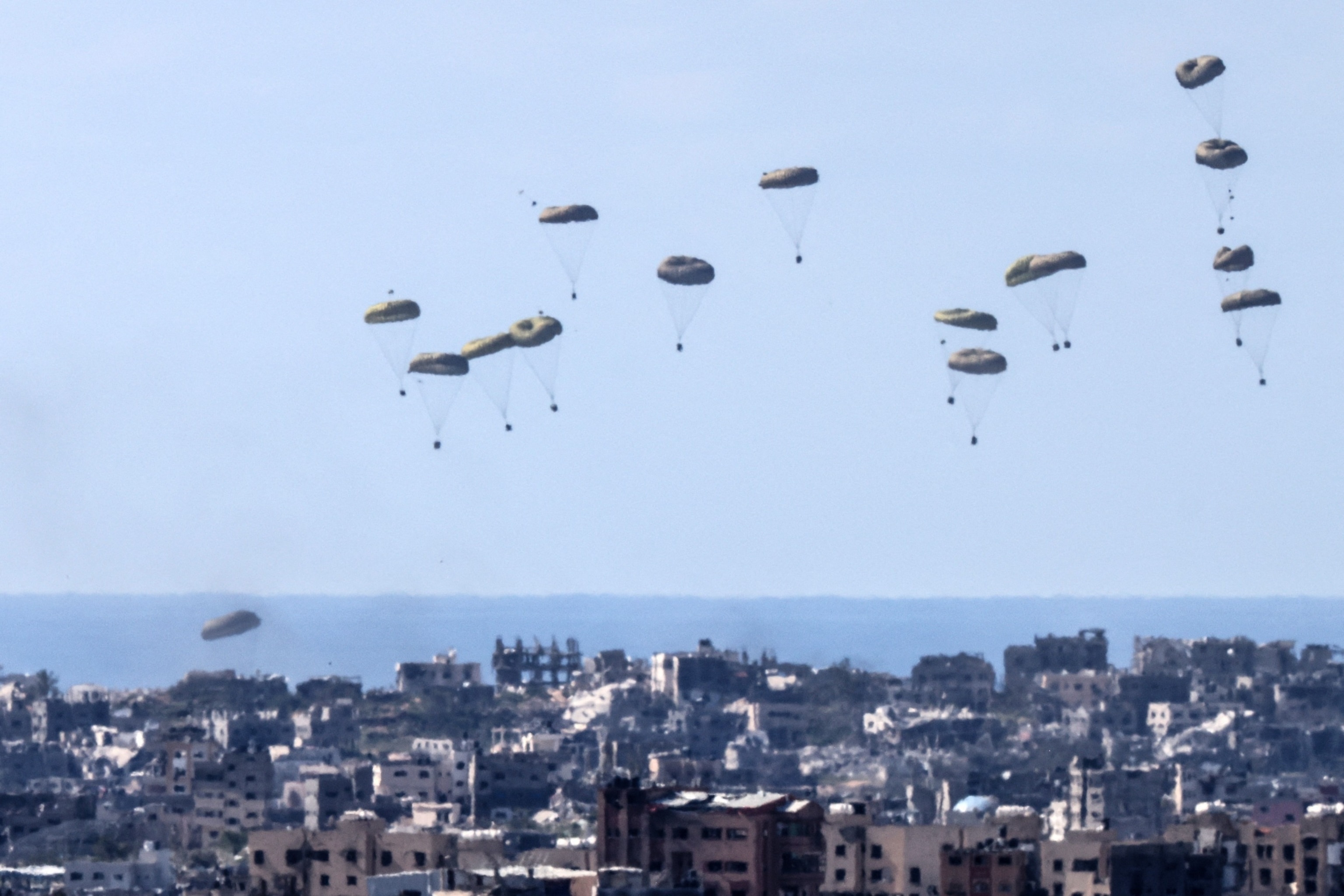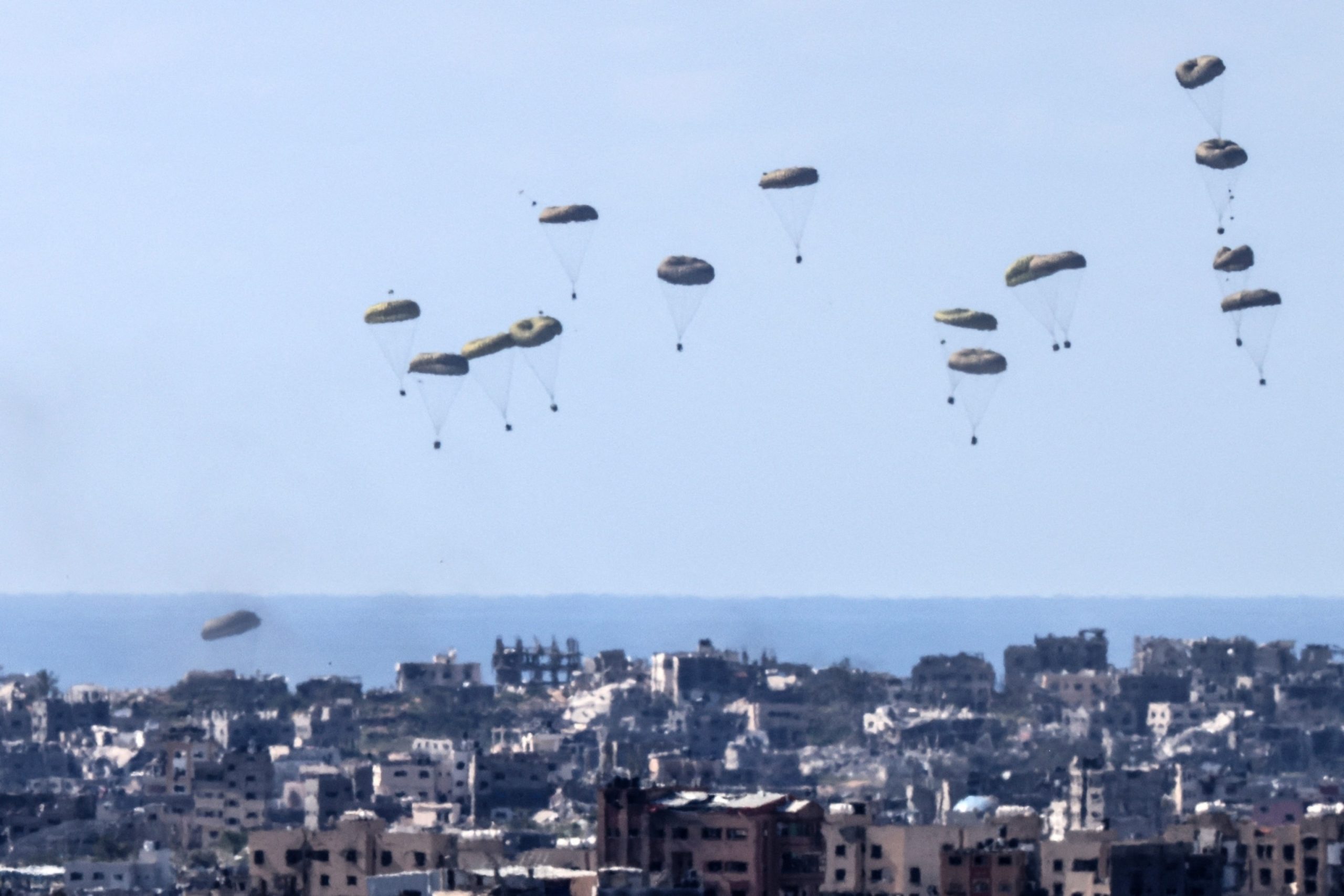The U.S. Air Force and the Royal Jordanian Air Force teamed up Sunday in the latest mission to airdrop desperately needed humanitarian aid into northern Gaza to “alleviate human suffering” there, according to a statement from the U.S. Central Command.
The equivalent of more than 11,500 meals, including rice, flour, pasta and canned goods, that were provided by the Jordanian Air Force were loaded on U.S. Air Force C-130 planes that dropped pallets of aid attached to parachutes over northern Gaza, the U.S. Central Command, or CENTCOM, said in a statement.
“These airdrops are part of a sustained effort, and we continue to plan follow-on aerial deliveries,” CENTCOM said.

Humanitarian aid is airdropped by a military transport aircraft above the northern Gaza Strip, as seen from the Israeli side in southern Israel, Mar. 10, 2024.
Menahem Kahana/AFP via Getty Images
The airdrops were made around 2 p.m. local time as part of an effort to “provide essential relief to civilians in Gaza affected by the ongoing conflict,” according to CENTCOM’s statement.
It was the second consecutive day humanitarian aid drops were made in northern Gaza.
Since the Hamas terrorist group’s surprise attack on Israel on Oct. 7, more than 31,000 have been killed in Gaza and at least 72,524 others injured, according to the Hamas-run Gaza Ministry of Health. In Israel, at least 1,200 people have been killed, according to the Israeli Prime Minister’s Office.
At least 23 people have now died of malnutrition in the Gaza Strip, including three children who reportedly perished Friday from malnutrition and dehydration at the Al-Shifa medical complex, according to the Gaza Ministry of Health.

An Air drop over Gaza as seen from a position on the Israeli side of the border, in southern Israel, Mar. 10, 2024.
Amir Levy/Getty Images
On Saturday, U.S. Air Force C-130 planes dropped the equivalent of more than 41,400 meals and 23,000 bottles of water into an area in northern Gaza where, according to CENTCOM, there is a “great need, allowing for civilian access to the critical aid.”
“The amount of aid flowing to Gaza is not nearly enough and we will continue to pull out every stop we can to get more aid in,” President Joe Biden wrote in a March 2 post on the social media site X, formerly known as Twitter.
The aid drops come amid continued calls from international humanitarian organizations for a cease-fire — as the Holy month of Ramadan approaches — and a release of the Israeli hostages being held in Gaza. There are about 134 hostages still believed to be in captivity in Gaza, 130 of them related to the current war and four related to the 2014 conflict. Of the 134, at least 32 are believed to be dead, according to the Israel Defense Forces and the Israeli Prime Minister’s Office.
“There is nowhere safe for people to go. The civilian death toll and the ongoing captivity of hostages are shocking and unacceptable,” the International Committee of the Red Cross and the Red Crescent said in a statement Saturday.
Biden said on Friday the chances of securing a cease-fire deal between Israel and Hamas before Ramadan begins on Sunday night are “tough.”
Meanwhile, hundreds of truckloads of humanitarian aid have been stuck waiting to be distributed in Gaza as the humanitarian crisis worsens, according to international organizations.
Between 200 and 300 truckloads from Israel into southern Gaza were at the Kerem Shalom crossing point Tuesday, waiting to be picked up and distributed, according to Israeli officials from the Coordination of Government Activities in the Territories (COGAT).
The distribution of aid in Gaza and getting it to those most in need in the north is one of the most pressing issues, COGAT said. Fifteen trucks carrying food and flour entered the north Gaza Strip on Wednesday, according to a COGAT post on X.
The humanitarian air drops followed allegations by the Hamas-run Gaza Ministry of Health that five children were killed in the Gaza Strip by a humanitarian aid airdrop from an unidentified foreign country on Friday. Several Palestinian civilians were also reportedly injured in the airdrop, according to the Government Media Office in Gaza, which called the airdrop “random.”
CENTCOM said in a statement Friday night it was aware of reports of civilians killed as the result of humanitarian airdrops but said it was not the result of a U.S. airdrop. During a news briefing Friday evening, Pentagon press secretary Maj. Gen. Pat Ryder said, “Press reports that U.S. air drops resulted in civilian casualties on the ground are false, as we’ve confirmed that all of our aid bundles landed safely on the ground.”
ABC News’ Shannon Crawford contributed to this report.
The United States Central Command (CENTCOM) recently reported that the US and Jordanian militaries collaborated on a humanitarian mission to deliver 11,500 meals to the residents of northern Gaza through an airdrop operation. This joint effort aimed to provide much-needed assistance to the people of Gaza who have been facing food shortages and other challenges due to ongoing conflicts in the region.
The airdrop operation was carried out with precision and efficiency, ensuring that the meals reached their intended recipients in a timely manner. The collaboration between the US and Jordanian militaries highlights the importance of international cooperation in addressing humanitarian crises and providing aid to those in need.
The delivery of meals to northern Gaza is just one example of the ongoing efforts by the US and its allies to support the people of Gaza and promote stability in the region. In addition to providing food aid, the US has also been working with international partners to address other pressing issues in Gaza, such as access to clean water, healthcare, and education.
The airdrop operation in northern Gaza serves as a reminder of the critical role that military forces can play in humanitarian missions. By leveraging their logistical capabilities and expertise, militaries can help deliver aid to remote or inaccessible areas, where traditional methods of transportation may not be feasible.
Overall, the collaboration between the US and Jordanian militaries in delivering meals to northern Gaza demonstrates a commitment to helping those in need and promoting peace and stability in the region. It also underscores the importance of international partnerships in addressing complex humanitarian challenges.



